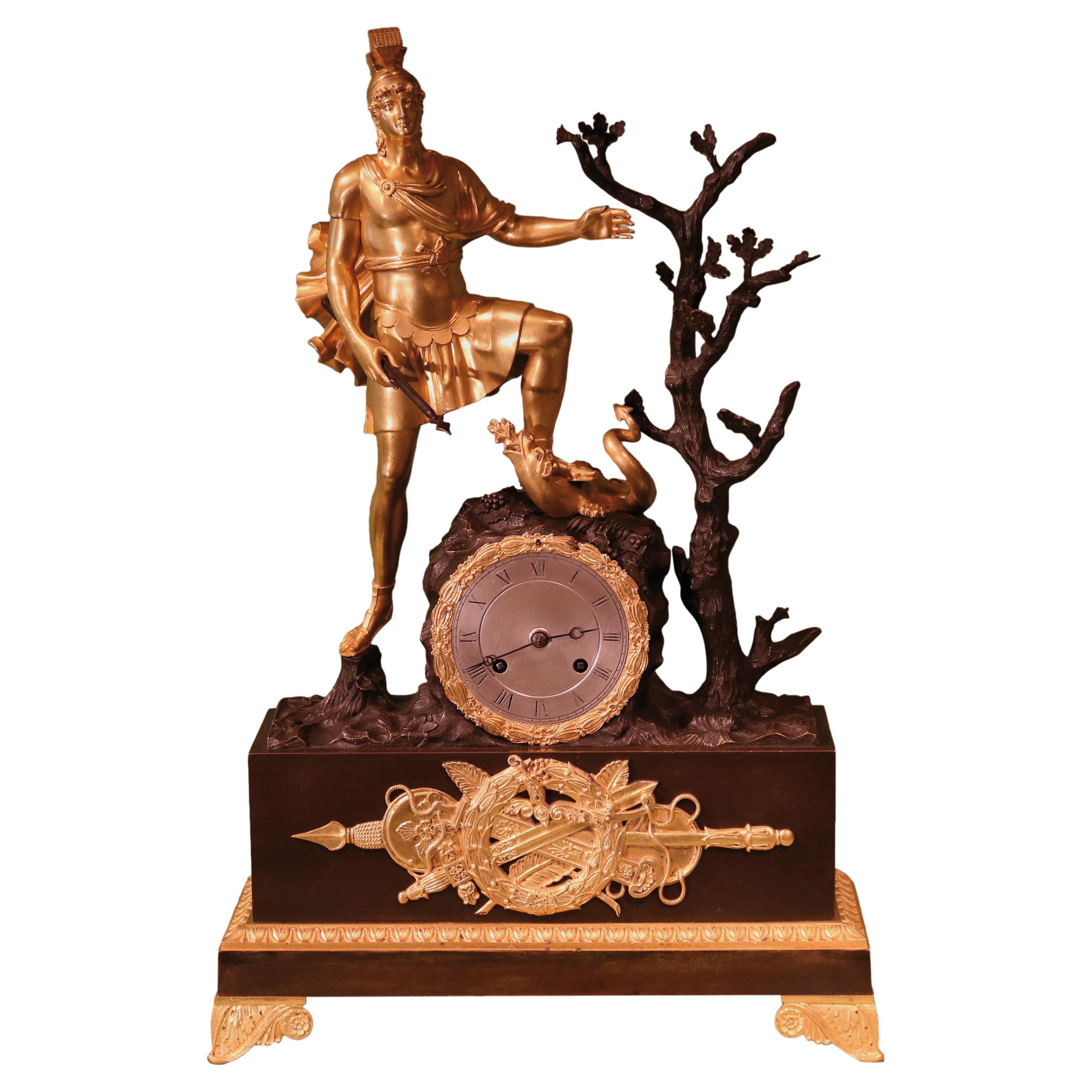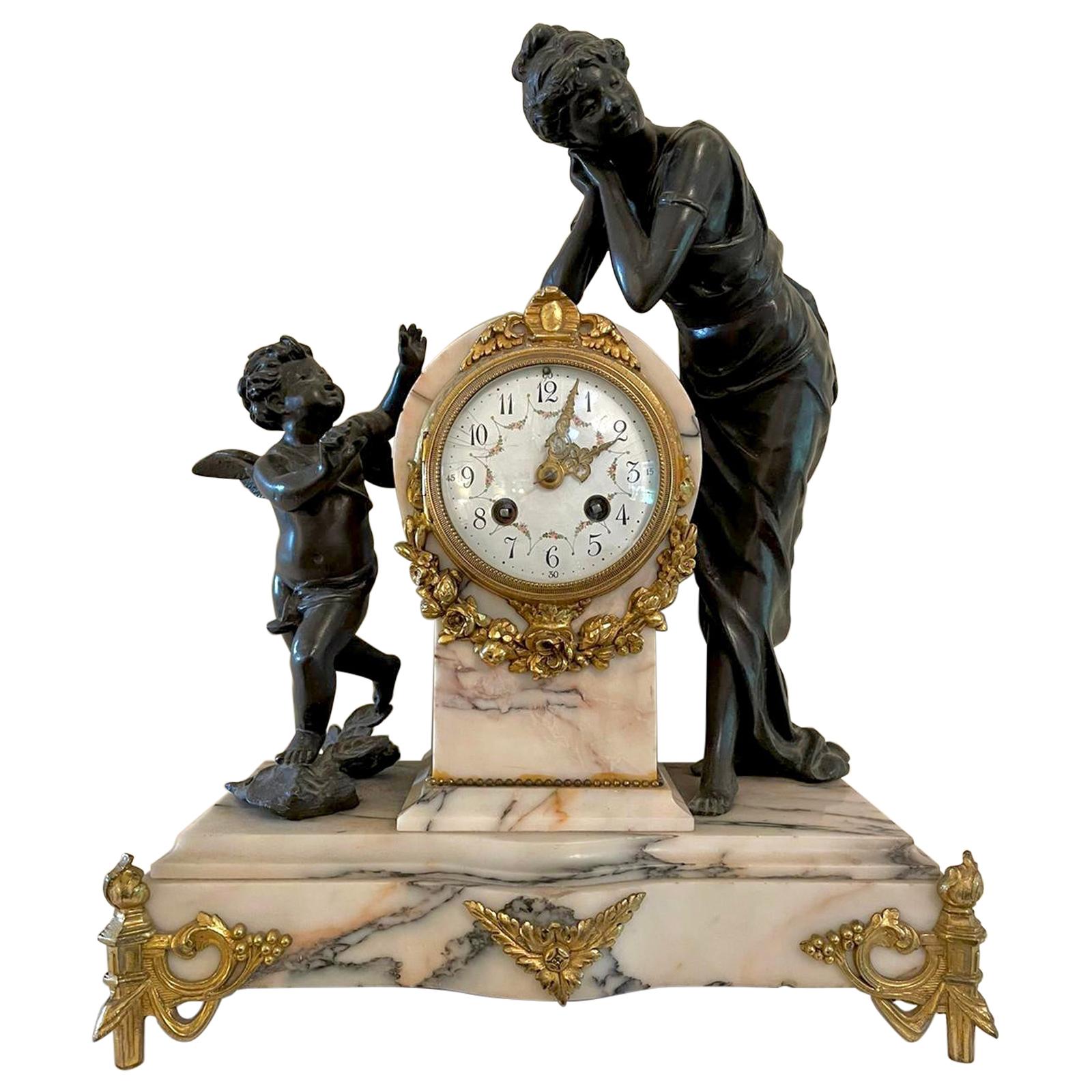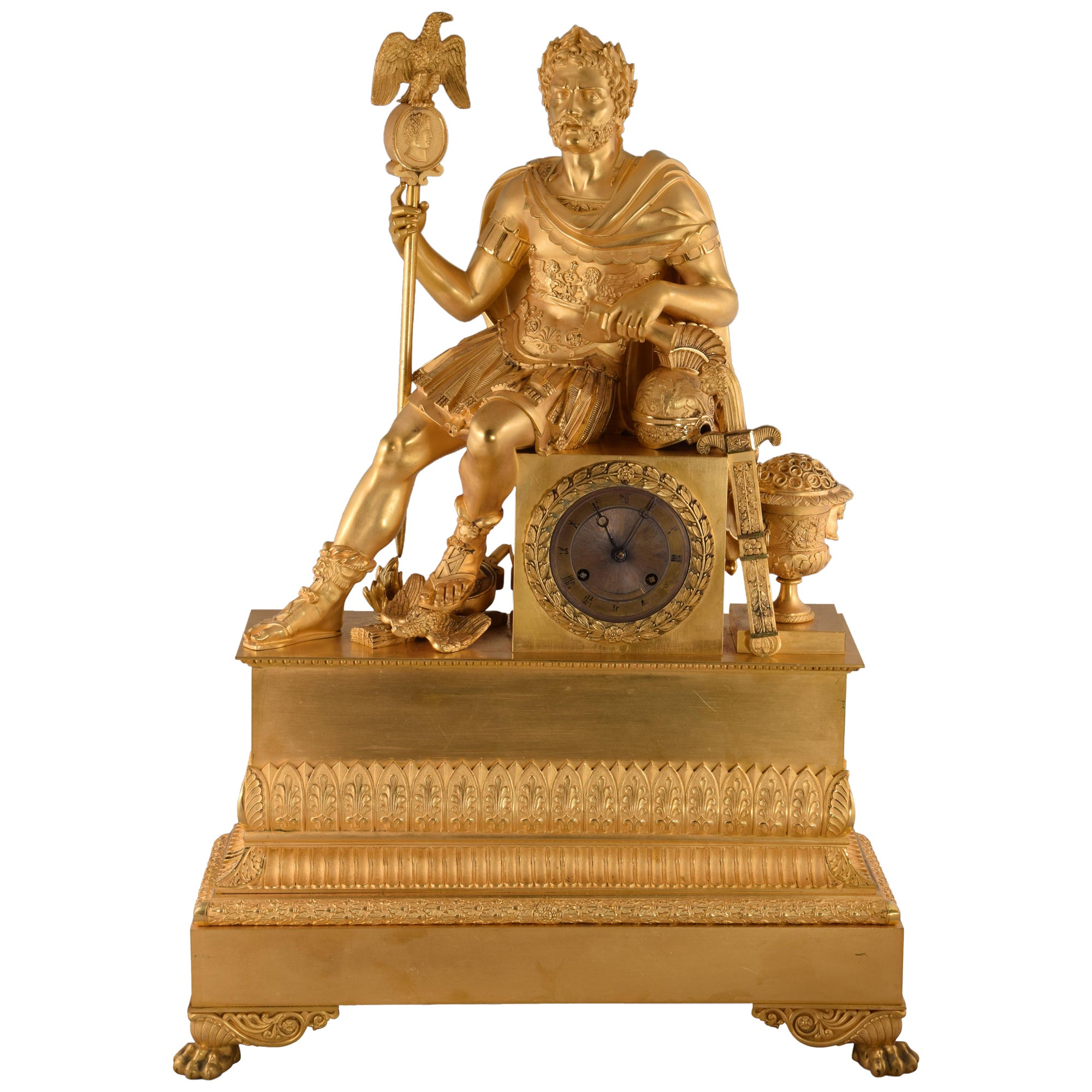Items Similar to Early 19th Century French Bronze and Ormolu Eight Day Striking Clock
Want more images or videos?
Request additional images or videos from the seller
1 of 7
Early 19th Century French Bronze and Ormolu Eight Day Striking Clock
About the Item
An early 19th century French eight day silk-suspension, striking clock, contained in ormolu case mounted with vases and urns of flowers with well-cast bronze figure of a muse holding a wreath of flowers, all supported on plinth engraved with central panel of Bacchus and grape vines, flanked by panels of musical instruments.
- Dimensions:Height: 16 in (40.64 cm)Width: 12 in (30.48 cm)Depth: 4 in (10.16 cm)
- Style:Neoclassical Revival (Of the Period)
- Materials and Techniques:
- Place of Origin:
- Period:
- Date of Manufacture:1840
- Condition:Repaired: Minor restoration consistent with use over the years. Wear consistent with age and use.
- Seller Location:London, GB
- Reference Number:1stDibs: LU1013425610702
About the Seller
5.0
Vetted Seller
These experienced sellers undergo a comprehensive evaluation by our team of in-house experts.
Established in 1984
1stDibs seller since 2013
65 sales on 1stDibs
Typical response time: 8 hours
Associations
The British Antique Dealers' AssociationLAPADA - The Association of Arts & Antiques Dealers
- ShippingRetrieving quote...Ships From: London, United Kingdom
- Return PolicyA return for this item may be initiated within 14 days of delivery.
More From This SellerView All
- Early 19th Century French Bronze and Ormolu 8 Day Mantle ClockLocated in London, GBAn early 19th Century French bronze & ormolu 8-Day striking Clock with silver dial (stamped Douon on inner plate and one spring dated 1824) mounted in unusual bronze & ormolu case depicting centurion slaying dragon...Category
Antique 19th Century French Regency Mantel Clocks
MaterialsBronze, Ormolu
- Bronze and Ormolu Clock, 19th Century, French, Silk Suspension StrikingLocated in London, GBAn early 19th century French bronze and ormolu eight day silk suspension striking clock contained in ornate case surmounted by well-cast and gadrooned urn...Category
Antique Early 19th Century French Regency Mantel Clocks
MaterialsBronze, Ormolu
- 19th Century French Bronze and Ormolu Clock GarnitureBy A.D. MouginLocated in London, GBA fine quality late 19th century French bronze and ormolu garniture, the 8-day striking enamelled dial movement by AD Mougin - Paris, contained in ormolu cas...Category
Antique Late 19th Century French More Clocks
MaterialsMarble, Bronze, Ormolu
- 19th Century French Empire Bronze & Ormolu Egyptian Style Clock ClockLocated in London, GBA French Empire bronze and ormolu clock in the Egyptian style with 8 day silk-suspension striking movement by Hemon a Paris, also marked “Ledure Bronzier”, enclosed in bronze obelisk...Category
Antique 19th Century French Egyptian Clocks
MaterialsBronze
- An early 19th century French bronze and marble mantel clockLocated in London, GBAn impressive early 19th Century French bronze 8-day striking Clock with silver dial surmounted by Spartacus, breaking his chains perched on rocks with quiver and shield raised on Sienna marble base mounted with military plaque...Category
Antique Early 19th Century French Régence Mantel Clocks
MaterialsMarble, Bronze
- Antique early 19th century French bronze and Sienna marble mantle clockLocated in London, GBA large and impressive early 19th Century French bronze & Sienna marble Clock surmounted with well-cast bust of Jupiter. The Clock, having 8-day s...Category
Antique Early 19th Century French Empire Mantel Clocks
MaterialsMarble, Bronze
You May Also Like
- Antique 19th Century French Bronze Ormolu and Marble 8 Day Striking Mantel ClockLocated in Suffolk, GBAntique 19th century French bronze ormolu and marble eight day striking mantel clock having two magnificent quality bronze figures, one being a ...Category
Antique 19th Century French High Victorian Mantel Clocks
MaterialsMarble
- 19th Century French Bronze and Ormolu ClockBy Claude GalleLocated in Scottsdale, AZ19th Century French Bronze and Ormolu Clock. circa 1810 clock Napoleonic Empire Bronze Dore. La Liseuse" clock after Reiche, by Claude Galle & Grand Girad. Signed in ParisCategory
Antique Mid-19th Century French Napoleon III Table Clocks and Desk Clocks
MaterialsBronze
- Table clock, Aníbal Barca. Ormolu bronze, metal. France, 19th century.Located in Madrid, ESTable clock, Aníbal Barca. Ormolu bronze, metal. France, 19th century. Table clock with Paris machinery and a case made of mercury-gilded bronze. in mercury-gilded bronze, with a rec...Category
Antique 19th Century European Neoclassical Revival Mantel Clocks
MaterialsBronze, Other
- Garniture, clock and candelabra. Bronze, porcelain. France, 19th century.Located in Madrid, ESGarnish with clock and candelabra in porcelain and gilt bronze. France, 19th century. Mechanism in perfect working order. Fireplace garnish composed of a clock and two five-light candelabras, all three pieces made by combining gilt bronze, with relief elements and round bulges and cold-chiseled details, and porcelain decorated with low-temperature enamels, including gold enamel. The porcelain pieces follow models from the Sèvres National Manufacture of the 18th century, with large pictorial cartouches on a cobalt blue background adorned with golden plant motifs. The set follows a historicist design that combines baroque and neoclassical elements with enamelled scenes of Rococo inspiration, representing landscapes and scenes with mythological themes alluding to the arts and the goddess Venus. The clockwork is stamped “Chles. MT”, with serial number 17420. The main glazed porcelain plates are signed DP Boncher. The clock follows an architectural structure, with an oval base with a prominent front in plan, raised on four molded feet in the shape of a top, on which a large ornamental vase is placed. This plinth has a distinct pinto and, above it, a main body as a façade, with a circular pediment that houses the clock face. This includes black enamelled Roman numerals on white medallions with a gold border, arranged around the central representation of a putti reclining among clouds, holding a floral garland and accompanied by musical instruments. Among the medallions that house the numbers, a small jeweled decoration that evokes pearls and embedded rubies, which is echoed in the secondary areas of the body of the piece and also the vase, always combined with delicate golden filigrees. On both sides of the sphere are two female portraits of ladies from the 18th century, in oval frames. Below, a classically inspired scene with a muse holding musical instruments, probably Euterpe or Erató, accompanied by a putti reading a sheet of music. On the sides of the clock body, two large curved rectangular plates house highly pictorial enameled landscapes, worked with the same miniaturist precision as the rest of the enameled cartouches. These are landscapes of romantic heritage, again inspired by the 18th century, with ideal settings for a twilight atmosphere, featuring classical ruins. The vase that tops the body of the clock has a hemispherical tank, shoulders ending in an edge, an openwork truncated conical neck, which opens smoothly towards the shoulders, and a domed lid, also openwork. The handles are figurative, in bronze, with two female sisters crowned with flowers, of clear Greco-Latin inspiration, worked in a round shape. In the tank, the vase houses two enameled porcelain cartouches, the front one with two putti and a dove - a symbolic allusion to Venus - and the back one with musical instruments. The design of the clock is completed by two thick bronze S-shaped plant braces, under the vase, and counter moldings and plant motifs cast in relief and cold chiseled, combining matte and polished finishes. The candelabras follow a similar design, with large vases of neoclassical design on pedestals, in this case cylindrical, raised on four low feet of turned design. The bases house porcelain cartouches with scenes of putti related to the arts; In one of them we see two putti practicing painting, and in the other two others in a scene related to classical lyric poetry, with one putto writing while the other, holding a lyre, raises a laurel wreath above his head. The cartouches that occupy the front of the candelabra vases...Category
Antique 19th Century French Neoclassical Revival Mantel Clocks
MaterialsMetal, Bronze, Other
- French Empire Bronze Ormolu-Mounted Figural Clock, Early 19th cLocated in valatie, NYThis handsome bronze mantel clock is from the French Empire period with a standing figure placing his feathered hat on top of the clock. The clock’s enameled face is surrounded by an...Category
Antique Early 19th Century French Mantel Clocks
MaterialsBronze
- 19th Century French Slate & Bronze Clock by MartiBy S. Marti & CieLocated in Dallas, TXPRESENTING A STUNNING 19C French Slate & Bronze Clock by Marti. Made circa 1860 by the famous French Clockmaker, J. Marti et Cie of Paris. Marti Clocks are highly desirable and highly collectible, BUT this Clock is one of the FINEST EXAMPLES of a Marti Black Slate and Bronze mantel clock we have EVER seen. The bronze detailing is SPECIAL. From the top, the clock is topped by a floral and ball bronze finial on square plinth or platform. Then it extends to an angular arched pediment with bronze floral wreath insert into the center. The next section, consists of a central bronze scene of 2 cherubs floating on water with a fish. This is flanked on either side by a floral rose medalion in bronze. It then extends downwards with 2 Corinthian Style bronze columns, with the main insert being bronze neo-classical or goddess figures (each one different than the other). The dial, clock face...Category
Antique Mid-19th Century French Neoclassical Revival Mantel Clocks
MaterialsSlate, Ormolu, Bronze
Recently Viewed
View AllMore Ways To Browse
19th Century French Bronze Clocks
19th Century Ormolu Clock
19th Century French Ormolu Clock
Eight Clock
French Gold Clock 19th Century
Striking Clock
French Ormolu Bronze Clock
Striking Clock Antique Clocks
Eight Day Clock
Antique Eight Day Clocks
Eight Day Clocks Antique
Gold Ormolu Clock
Early 19th Century French Clock
French Figural Bronze Clock
Gold Ormolu French Mantel Clock
19th Century Bronze Figural Clock
Bronze Neoclassical Clock
French Neoclassic Bronze Clock





